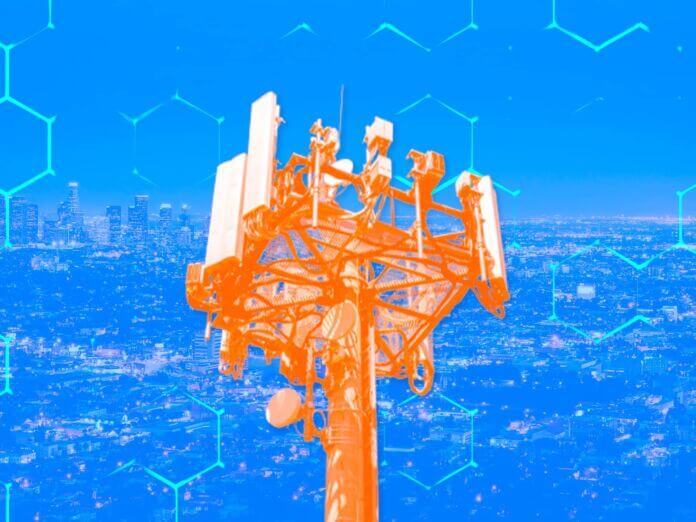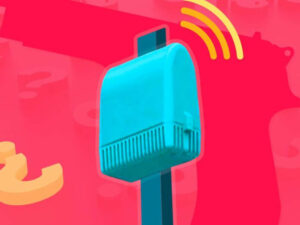
Thanks to several advantages over previous terrestrial network generations, 5G is set to revolutionize IoT. With ultra-high speed (10 times faster) and low latency, 5G allows devices to collect and transmit data almost instantly, ideal for mission-critical IoT applications. 5G’s increased capacity and improved reliability also allow for a much larger number of devices to connect to the internet, paving the way for even more advanced IoT applications.
Further, 5G’s network slicing allows for the creation of virtualized network segments that can be optimized for specific IoT use cases, enhancing performance and efficiency in IoT deployments. But 5G was primarily designed to improve network coverage in urban areas with high population density.
To date, just 8 percent of the globe’s surface is covered by 5G with terrestrial networks more generally at 15 percent. Let’s explore the increasing role of satellites in 5G’s future and exactly how close this future is to reality.
Satellites Complement 5G Networks
Ultimately, satellites could be used to complement 5G networks in three main ways:
- Expanding coverage to include rural, remote areas
- Creating redundancies
- Additional backhaul
While connectivity is about more than just coverage, incorporating satellites into 5G networks provides the primary benefit of complete global coverage. Unlike traditional mobile networks and fiber connectivity which rely on infrastructure, satellites can deliver connectivity anywhere on the planet.
“While connectivity is about more than just coverage, incorporating satellites into 5G networks provides the primary benefit of complete global coverage.“
In addition, Low Earth Orbit (LEO) satellites can offer high-speed, low-latency connectivity. As LEO satellites are positioned between 160-2,000km (99-1243 miles) from the Earth’s surface, they can deliver latency as low as 20 milliseconds, similar to that achievable through terrestrial networks.
So time-sensitive applications such as remote surgery or autonomous vehicles where delays can have severe consequences, can be managed using satellite connectivity. Furthermore, the added bandwidth could position 5G networks to handle the growing data traffic and the number of connected devices.
Though these benefits are reasonably well understood, even in 2022, just two percent of the global satellite connectivity market is related to satellite IoT revenues. So, what’s changed? In short, factors associated with the two most common barriers to satellite connectivity adoption – cost and complexity – are evolving.
Cost-Effective Satellite Connectivity
Satellites were previously considered a costly last option, but the satellite communications industry has witnessed remarkable growth and innovation in recent years. The cost of launching satellites into Low Earth Orbit (LEO) has decreased significantly from $85K per kg in 1981 to just $1K per kg in 2020.
The development of smaller, lighter nano and CubeSats has contributed to this trend. However, as nanosatellites provide less coverage due to their small size, a larger number of them is required to achieve global coverage. Swarm’s global coverage is supported by a constellation of 150 nanosatellites, whereas Iridium’s network comprises 66 satellites.
The satellite communications industry has also become increasingly competitive with several new players entering the market in the last few years alone. But many are still in the process of launching their nano or CubeSat networks. Consequently, some of these operators will lack the capacity to offer real-time data or in some cases, truly global coverage.
For instance, Astrocast and Sateliot have 18 and 12 nanosatellites in orbit respectively, with plans to increase their overall constellations to 1,000 and 250. Simply, some of these operators may only be able to deliver IoT data a few times, or even once per day, which may not be suitable for all use cases. In these situations, businesses need to be clear about the frequency of transmissions needed for their project, and carefully select a satellite network that can support that.
Interoperability Opportunities & Challenges
Currently, many satellite operators require customers to use proprietary equipment to access their network. This means buying a standalone satellite transceiver designed for this purpose – but not always straightforward to integrate with existing systems. Some devices will support your chosen messaging protocol; in other cases, users will need to manipulate their data to make it possible to transmit data over satellite.
Interoperability has been a topic of conversation in the communications industry for some time, but it wasn’t until 2017 that a formalized working group recommended integrating non-terrestrial networks such as fiber and satellites into 5G technology.
In 2023, there are promising developments in the direct-to-device space, such as Qualcomm’s new Snapdragon X75 chipsets that leverage Iridium’s satellite network and eliminate the need for additional sim or hardware to leverage satellite connectivity.
However, interoperability for IoT deployment connectivity is further complicated by the increasing number of wireless connectivity options. To name just a few, 5G NR (New Radio), NB-IoT (Narrowband Internet of Things), and LoRaWAN (Long Range Wide Area Network).
As interoperability capabilities have to be built into satellites before launch, essentially, satellite network operators need to choose the protocols or/and standards they believe will be around for the long term. After all, it’s not uncommon for terrestrial networks to sunset specific generations of service as is currently underway with 2G and 3G.
Additionally, there are still some challenges and limitations to be addressed, not least, regulatory issues such as spectrum allocation which need to be overcome.
The Future: Hybrid, Ubiquitous Coverage
There is an increasing trend of terrestrial and satellite IoT network operators collaborating to offer hybrid connectivity solutions. For instance, Kinéis and Deutsche Telekom have partnered to offer hybrid cellular-satellite solutions, where Kinéis’ KIM 1 module is certified by Deutsche Telekom and can be utilized by the latter’s customers.
What’s more, many satellite IoT devices, for example, the RockREMOTE Rugged, can leverage both cellular and satellite connectivity. In both cases, separate sim cards are required for cellular and satellite connectivity and devices will use terrestrial connectivity when available, switching to satellite when terrestrial coverage is unavailable.
What’s more, new technologies that provide terrestrial and satellite connectivity through a single communication Radio Frequency (RF) chipset are emerging. An example of this is the LoRa Edge LR1120 which supports Sub-GHz LoRa, SATCOM S-band, and 2.4 GHz Lora.
Though the reality of a fully interoperable network solution is still several years away, even more established satellite operators are considering partnerships to diversify their offerings. Bryan Hartin, executive vice president at McLean, Va.-based Iridium, recently gave an interview where he talked through the success of the Qualcomm partnership and said, “There might be an NB-IoT player out there that we might say okay, just to diversify our reach a little bit, we could look at investing in 1 or 2 of them.”
5G and Satellites
Ultimately, reliable connectivity is key to the success of any IoT deployment, and satellite technology is already being used in numerous applications, including precision agriculture, logistics, and healthcare. Continued investment and collaboration in this area are crucial for realizing the full potential of satellite-based IoT networks. Until then, the combination of satellite and 5G networks still delivers businesses and organizations great flexibility to realize the full potential of space.
- SEO Powered Content & PR Distribution. Get Amplified Today.
- PlatoAiStream. Web3 Data Intelligence. Knowledge Amplified. Access Here.
- Minting the Future w Adryenn Ashley. Access Here.
- Buy and Sell Shares in PRE-IPO Companies with PREIPO®. Access Here.
- Source: https://www.iotforall.com/connecting-the-next-billion-5g-and-satellites
- :has
- :is
- :not
- :where
- 000
- 1
- 12
- 15%
- 20
- 2017
- 2020
- 2022
- 2023
- 250
- 5G
- 5G networks
- 66
- 7
- 8
- a
- Able
- About
- access
- Achieve
- added
- addition
- Additional
- Adoption
- advanced
- advantages
- After
- agriculture
- All
- allocation
- allow
- allows
- alone
- already
- also
- always
- an
- and
- any
- anywhere
- applications
- ARE
- AREA
- areas
- around
- AS
- associated
- At
- autonomous
- autonomous vehicles
- available
- away
- Bandwidth
- barriers
- BE
- become
- been
- before
- being
- believe
- benefit
- benefits
- between
- Billion
- Bit
- both
- Bryan
- built
- businesses
- but
- Buying
- by
- CAN
- capabilities
- Capacity
- Cards
- carefully
- cases
- Certified
- challenges
- changed
- chipset
- Choose
- chosen
- clear
- Close
- CO
- collaborating
- collaboration
- collect
- combination
- Common
- Communication
- Communications
- competitive
- Complement
- complete
- complexity
- complicated
- comprises
- Connect
- connected
- connected devices
- Connecting
- Connectivity
- Consequences
- Consequently
- considered
- considering
- continued
- contributed
- Conversation
- Cost
- costly
- could
- coverage
- covered
- creation
- crucial
- Currently
- Customers
- data
- Date
- day
- delays
- deliver
- delivers
- density
- deployment
- deployments
- designed
- DEUTSCHE TELEKOM
- Development
- developments
- Devices
- diversify
- due
- earth
- Edge
- efficiency
- eliminate
- emerging
- enhancing
- entering
- equipment
- essentially
- established
- Ether (ETH)
- Even
- evolving
- exactly
- example
- executive
- existing
- explore
- factors
- few
- Flexibility
- For
- Frequency
- from
- full
- fully
- further
- Furthermore
- future
- generally
- generations
- Global
- great
- Group
- Growing
- Growth
- handle
- Hardware
- Have
- he
- healthcare
- High
- How
- However
- HTTPS
- Hybrid
- ideal
- improve
- improved
- in
- In other
- include
- Including
- incorporating
- Increase
- increased
- increasing
- increasingly
- industry
- Infrastructure
- Innovation
- instance
- instantly
- integrate
- Integrating
- Internet
- internet of things
- Interoperability
- interoperable
- Interview
- into
- investing
- investment
- iot
- iot devices
- IoT use cases
- issues
- IT
- jpg
- just
- Key
- Kim
- Lack
- larger
- Last
- Latency
- launch
- launching
- least
- LEO
- less
- Leverage
- lighter
- limitations
- little
- logistics
- Long
- Look
- LoRaWAN
- Low
- Main
- make
- managed
- many
- Market
- max-width
- May..
- means
- messaging
- might
- Mobile
- mobile networks
- module
- more
- most
- much
- name
- nano
- Need
- needed
- network
- networks
- New
- New technologies
- next
- number
- numerous
- of
- offer
- Offerings
- Okay
- on
- once
- only
- operators
- opportunities
- optimized
- Option
- Options
- or
- Orbit
- organizations
- Other
- our
- out
- over
- overall
- Overcome
- partnered
- Partnership
- partnerships
- Paving
- percent
- performance
- planet
- plans
- plato
- Plato Data Intelligence
- PlatoData
- player
- players
- population
- position
- positioned
- possible
- potential
- Precision
- president
- previous
- previously
- primarily
- primary
- process
- project
- promising
- proprietary
- protocol
- protocols
- provide
- provides
- purpose
- qualcomm
- Radio
- range
- reach
- real-time
- real-time data
- Reality
- realize
- realizing
- recent
- recently
- recommended
- regulatory
- related
- reliability
- reliable
- rely
- remarkable
- remote
- require
- required
- respectively
- revenues
- revolutionize
- Role
- Rural
- Said
- satellite
- satellites
- say
- segments
- separate
- service
- set
- several
- severe
- Short
- significantly
- SIM
- similar
- simply
- single
- situations
- Size
- small
- smaller
- So
- solution
- Solutions
- some
- Space
- specific
- Spectrum
- speed
- standalone
- standards
- Still
- straightforward
- success
- such
- suitable
- Sunset
- support
- Supported
- Supports
- Surface
- Surgery
- Systems
- Technologies
- Technology
- term
- terrestrial
- than
- that
- The
- their
- Them
- then
- There.
- These
- they
- things
- this
- three
- Through
- time
- time-sensitive
- times
- to
- topic
- traditional
- traffic
- transmit
- Trend
- truly
- two
- ubiquitous
- Uncommon
- understood
- Underway
- unlike
- until
- urban
- Urban Areas
- use
- used
- users
- using
- utilized
- Vehicles
- Vice President
- vodafone
- was
- Way..
- ways
- we
- WELL
- were
- when
- whereas
- which
- wide
- will
- wireless
- with
- witnessed
- working
- Working Group
- years
- Your
- zephyrnet










